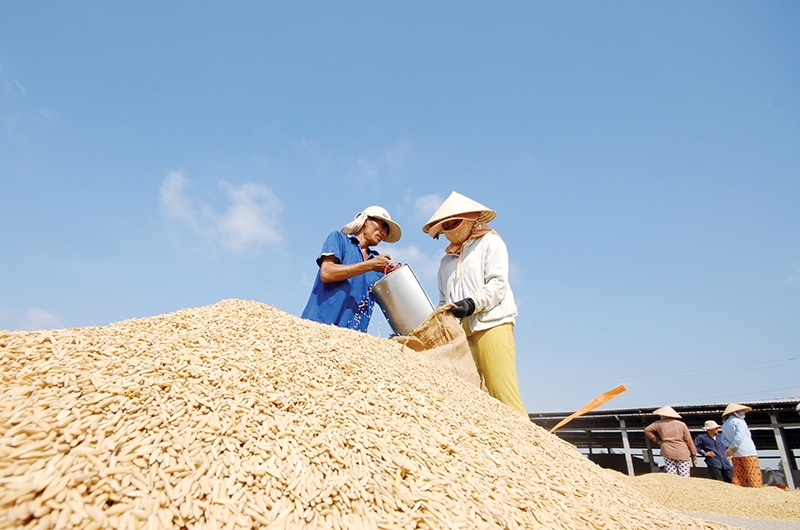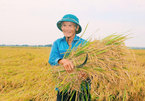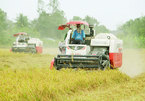 |
|
Vietnamese rice, particularly the popular ST25, is highly appreciated by the international community, photo Le Toan
|
Nguyen Quang Hoa, director of Duong Vu Co., Ltd. – one of the largest exporting and processing companies in the Mekong Delta province of Long An – described to VIR the details of another successful year for the company, with export volume of nearly 300,000 tonnes worth nearly $100 million.
“The exact figures are not yet available but they are much higher than last year. The company’s key export markets are the Philippines and China, and in 2021 we will continue to expand our customer base in these two countries,” Hoa said.
Figures from the Ministry of Agriculture and Rural Development show that, as of the end of 2020, the rice export quantity of Vietnam saw a light decrease of 2.5 per cent from 6.37 million tonnes in 2019, but still reaped a record export turnover of over $3 billion, up from $2.81 billion in the previous year. The average selling price of rice is approximately $490 per tonne, up 12.7 per cent on-year.
Pham Thai Binh, general director of Trung An Hi-tech Farming JSC, said that the increase in selling price came from an improvement in quality and lack of supply around the world.
Vietnam has an advantage in having three crops a year while other countries including Thailand and Cambodia can only muster one or two crops, and actually ran out of rice from around September, according to Binh. Meanwhile the market demand for rice is still on an uptrend, especially in the Philippines, the largest rice export market for Vietnam. “The demand will continue to climb as there is a general tendency of stocking up,” Binh said.
Standing behind India, Thailand is the second-largest rice exporter in the world – however, it has been difficult to maintain momentum due to unfavourable weather conditions, increase in the valuation of its currency, general fierce competition, and current trends in giving up rice cultivation.
“In addition, the import tariff on rice that the Philippines applies on countries in ASEAN is 30 per cent while the tariff applied on countries outside the bloc is 50 per cent, giving us an edge over global competition,” Binh said.
Improving the quality is deemed the key reason in pushing up prices. Instead of providing low-cost rice in the past, farmers and exporters are proactively in offering high-end rice to the world’s hardest markets, including South Korea and Europe.
For example, the Vietnamese ST25 rice was awarded the second prize at the World’s Best Rice Contest 2020, which took place within the framework of the 12th World Rice Conference in the United States in December via videoconference.
“Vietnamese rice has been the winner of top prizes in international competitions for four consecutive years, and ST25 rice has added to that. Indeed, many foreign partners have expressed their admiration for the country’s efforts to introduce Vietnamese brands to the wider international market,” said Ho Quang Cua, known as the father of ST25 rice.
The General Statistics Office forecasted that rice export turnover has numerous market space for growth, with a projected average increase by 15-20 per cent in valuation from now to 2025.
Free trade potential
Although the country’s export turnover saw a hike, the largest export destinations are still traditional markets such as China and the Philippines. Numerous rice processing and trading enterprises, including those operating outside the sector, are dreaming about taking advantage of the EU-Vietnam Free Trade Agreement (EVFTA) and the Regional Comprehensive Economic Partnership (RCEP). However, it may not be easy to immediately enjoy benefits from these deals.
Indeed, even Hoa from Duong Vu Co., Ltd., when asked about the possible benefits that could be gleaned from the RCEP in particular, revealed he knew almost nothing about it.
“I have yet to hear about the RCEP, so I cannot forecast the potential from this agreement,” he said. “Even the company’s market study team has yet to report any information on potential opportunities from this deal to me.”
Meanwhile, since the EVFTA came into effect in August 2020, Hoa’s company has been receiving proposals from foreign companies in the EU to order products. In addition, the director has had numerous friends in other local enterprises asking for his opinion about plans to skim profits from the agreement.
However, according to Hoa, almost all of these companies operate outside the rice processing and trading sector, thus risks for these enterprises could be sizable.
“I advised them to put these intentions on hold if they don’t have deep experience in this sector and knowledge about the market, despite the strong financial potential they may have,” Hoa said. “Numerous companies operating in this sector have yet to enjoy any benefits from the EVFTA. The tariff for rice is down to zero – however, Vietnamese rice faces difficulties in competing with those imported from Cambodia and Thailand.”
The EVFTA is nevertheless set to draw a bright future for Vietnamese rice. As part of the agreement, the EU offers Vietnam a quota of 80,000 tonnes of rice a year, subject to zero tariff rates, comprising 30,000 tonnes of husked rice, 20,000 tonnes of unhusked rice, and 30,000 tonnes of the fragrant variety, according to the Ministry of Industry and Trade. The EU will also fully liberalise the trade of broken rice, helping Vietnam export an estimated 100,000 tonnes there annually.
According to the Ministry of Agriculture and Rural Development, the EU consumes about 2.5 million tonnes of rice annually, with consumption in the market increasing significantly due to the popularity of Asian food.
A number of rice processing companies succeeded in exporting their first batches of rice to the EU after the agreement took effect. In late September, Loc Troi Group, which holds 17 per cent of the country’s total export quota to the EU, handled a batch of 126 tonnes of a jasmine rice variety to Europe, marking a part of Vietnam’s quota of 30,000 tonnes of the fragrant rice to this market.
Competitive neighbours
A director of one leading rice group told VIR, “This move has yet to prove real achievements. Since the agreement came into effect, many enterprises from the EU are looking for a big slice of the pie, thus the phenomenon of EU companies buying rice from Vietnam to export is understandable.”
The director added that the problem is that the purpose of many deals is to simply explore the market and so not all of the deals will be a success. “Loc Troi’s batch may be one of these tests. It will take one or two years to review the real effectiveness of exporting rice to this market,” he said.
According to his experience, a large number of customers in the EU have a preference for KDM rice (Khao Dac Mali, from Cambodia), which is harvested once a year from plantations in northwestern Cambodia and is also recognised as one of the world’s finest fragrant varieties. At the same time, a majority of rice grown in Vietnam consist of short-term crops of around three months each.
In addition, the director added that growing long-term crops is a traditional cultivation method in Cambodia and Thailand, which became their competitive advantage as Western consumers believe longer cultivation time results in better quality – although a number of local businesses have started to study to develop this method, albeit on a smaller scale.
A number of EU importers and hosts of retail stores said that rice from Thailand is not always better and cheaper than Vietnam’s, but it holds a solid position in the market thanks to its stability. Providers are always ensured a delivery deadline, correctly-ordered products, and correct weights. Especially, selling prices are stable, even if there are delays in international logistics networks.
Furthermore, the capacity of local producers remains weak, according to Binh of Trung An Hi-tech Farming JSC. Binh told VIR that the industry faces numerous risks, with production capacity being one of the biggest. Vietnam has about 150 rice exporting and processing enterprises, the majority of which do not have enough capacity in both management and finance to maintain operations.
“Looking at these factors, it is easy to see there are still difficulties for Vietnamese rice exporting to the EU in the future,” Binh said. VIR
Nguyen Oanh

Rice exporters have bumper year, VN becomes No 1 in the world
The year 2020 has been a challenging year for many business fields, but not for rice production and exports. Vietnam has surpassed India and Thailand in terms of rice export price.

Surpassing Thailand, Vietnam becomes No 2 rice exporter in the world
With a bumper crop and good export prices, Vietnam’s rice export volume and turnover have exceeded Thailand’s, making the former the second largest exporter amid the Covid-19 crisis.